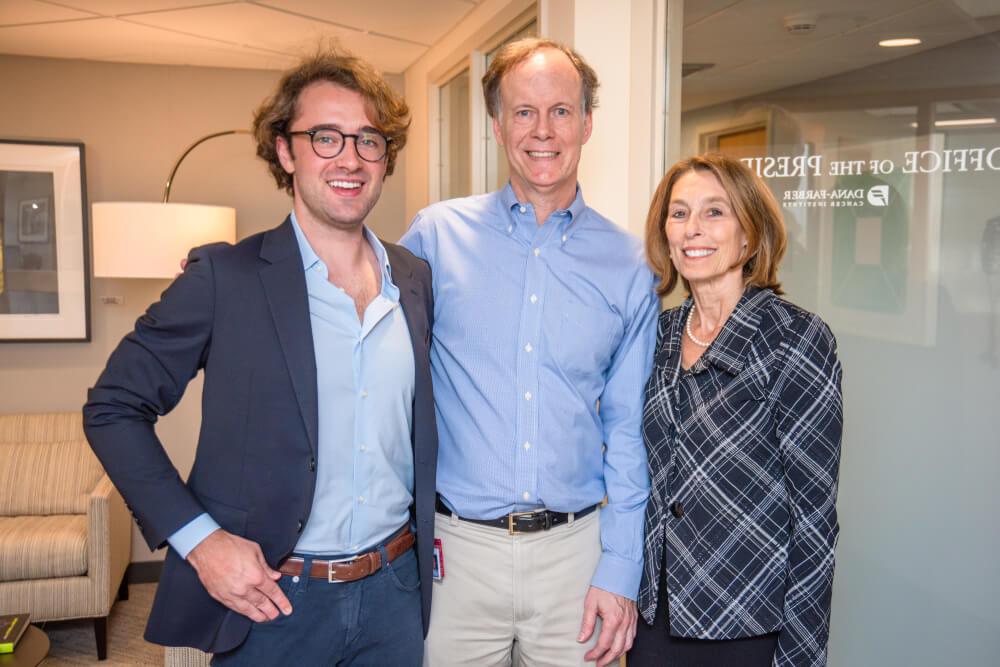There was always a good chance William G. Kaelin Jr., MD, and two other scientists working on the same problem would share a Nobel Prize, as they did on Oct. 7, for deciphering the mechanism that enables cells to sense and adapt to changes in oxygen abundance.
The three had already been honored with two major awards that often presage the most prestigious prize of all. Still, in any given year, one never knows, and Kaelin said he had always tried to tamp down the inevitable expectations.
“Of course, I knew it was Nobel Prize Monday when I went to bed Sunday night,” he said at a Dana-Farber press conference. He fell asleep, then awoke “from a very vivid dream,” he said, “where I looked at the alarm clock and it was 5:45 a.m.. So in my dream I said, ‘OK, another year it didn’t happen, but it’s OK.’”
But then he realized it was only 2:30 a.m. — too early for the announcement — he went back to sleep. When the phone rang just before 5 a.m., he thought: “Is this the dream part, or is this the awake part?”
It was the awake part. Kaelin, along with Sir Peter Ratcliffe of the University of Oxford, and Dr. Gregg Semenza of Johns Hopkins University, had just been awarded the 2019 Nobel Prize in Medicine, for their discoveries of the molecular system by which cells sense and adapt to varying levels of oxygen availability.
“It was just surreal,” he said. “I had this sort of out-of-body feeling of great appreciation and being so thrilled to share this with all the people who have meant so much to me.”

A celebration
After that overwhelming start to his day, Kaelin fielded calls and conducted interviews before arriving at an 11:30 a.m. press conference at Dana-Farber, where he was introduced by President and CEO Laurie H. Glimcher, MD, and received accolades from Harvard Medical School (HMS) Dean George Q. Daley, MD, and Elizabeth Nabel, MD, president of Brigham and Women’s Hospital (BWH).
Kaelin, the Sidney Farber Professor of Medicine at Dana-Farber and a professor of medicine at HMS and BWH, along with his co-winners Ratcliffe and Semenza, also jointly won the 2016 Lasker Award for basic medical research.
“We’re all incredibly proud of Dr. Kaelin – and hopeful for the promise this means for patients here and everywhere,” Glimcher said. The body’s mechanism for adapting to changing oxygen levels “is essential for survival,” she added, “and understanding it and being able to manipulate it are already being used to develop exciting new treatments for cardiovascular disease and cancer.”

HMS Dean Daley, who works in the field of hematology, called Kaelin “the consummate physician-scientist, the finest that medicine has to offer.” Nabel commented that the advances made by Kaelin and his co-awardees “are in cancer and way beyond.” She said that his achievements aside, Kaelin “is a wonderful, amazing individual and human being.”
Kaelin said at the press conference that he and his late wife, Carolyn Mary Kaelin, MD, MPH, had talked about what would happen if he won the Nobel. Carolyn Kaelin, a breast surgeon at Dana-Farber/Brigham and Women’s Cancer Center, died in 2015. In the years immediately following her death, Kaelin said he had hoped the prize would not come so soon.
“It would be too bittersweet, too crushing to receive it without Carolyn,” he said. “Now I like to think she’s looking down and smiling and saying, ‘See, I told you it was going to happen!”
Kaelin said that while he did not formally collaborate with the other two Nobel winners, he said the research was inherently collaborative.
“They were reading my papers and I was reading their papers, and when we would see each other at scientific conferences we were talking about things that were going to appear in publications six months later,” he said. “In my view, that really accelerated the field.”
He added that “science is done in an ecosystem” of collaborators and other scientists working in related fields. He made special mention of David Livingston, MD, in whose Dana-Farber laboratory Kaelin trained. “He was — and is — my mentor,” Kaelin said. “He taught me how to be a scientist.”
Kaelin’s research
In his Dana-Farber laboratory, Kaelin has focused on why mutations in genes known as tumor-suppressor genes can lead to cancer. One such tumor-suppressor gene called VHL, when mutated, causes von Hippel Lindau syndrome, a rare disorder that makes patients likely to develop kidney cancer, as well as other types of tumors.
Studying VHL led Kaelin and his co-awardees to a landmark discovery – the molecular explanation to a long-standing biological puzzle: How does the body sense and adapt to changes in oxygen — for example, when people adjust to thinner air at high altitudes.
Pursuing this question, he discovered that the VHL protein normally helps regulate the levels of an oxygen-sensitive protein called HIF, which can trigger or suppress the production of red blood cells and the formation of new blood vessels and discovered the molecular switch that renders HIF oxygen-sensitive. Cancer cells with mutated VHL genes commandeer this system to surround themselves with new blood vessels — a process called angiogenesis — to feed their growth.
Kaelin found that mutation of the VHL gene causes kidney tumors to churn out large amounts of a protein, VEGF, which helps provide them with an extra blood supply to fuel the cancer’s growth. His work on the VHL protein (the protein made with the “instructions” provided by the VHL gene) helped to motivate the eventual successful clinical testing of VEGF inhibitors for the treatment of kidney cancer. However, the first drug from his laboratory to receive approval for clinical use is a drug to stimulate the production of red blood cells to treat anemia.
Kaelin discovered that the VHL protein helps control the levels of the protein HIF, which ratchets up or down the response to low oxygen, such as the production of red blood cells and new blood vessels. He showed that one form of the protein, HIF-2α, drives certain kidney cancers, and he subsequently discovered how HIF-1α is hijacked by triple-negative breast cancers. He is developing therapeutic strategies for targeting these molecules. In fact, a HIF-2α inhibitor has now advanced to phase 3 clinical testing based on promising results when used to treat patients with kidney cancer.
“We are thrilled for Dr. Kaelin on this extraordinary honor,” said Glimcher. “It’s a discovery that has already led to important medical applications in areas like cancer, where the availability of oxygen is critical to the way cancer cells grow and survive.”
In addition to the Nobel and Lasker awards, Kaelin and his two Nobel Laureate collaborators earned the 2010 Canada Gairdner International Award and the Grand Prix of the Fondation Lefoulon-Delalande from the Institute of France in June 2012, for contributions to the field of cardiovascular research.
Kaelin also has received the Science of Oncology Award from the American Society of Clinical Oncology, the Princess Takamatsu Award from the American Association for Cancer Research, the Steven C. Beering Award, and the Wiley Prize in Biomedical Sciences. He has also been a Howard Hughes Medical Institute investigator since 1998.

Congratulations! In addition to his work on VHL and hypoxia cited by the Nobel Committee, Dr. Kaelin and his Dana Farber colleagues have made many seminal contributions in the field of cancer biology. These include elucidating the role of cyclins interacting with CDK enzymes in the 1990s. His work has led to insights on cancer cell addiction to oncogenes and spawned new drug development strategies. Thank you for showing the way!
Dana Farber continues to be the “best of the best” and not only lives up to its reputation, but excels and exceeds on all levels. Congratulations Dr. Kaelin. I am proud to have Dana Farber as my legacy.
Congratulations to Dana Farber and their Nobel Prize winners
Anyone who is a patient at Dana Farber knows that we have the best physicians in the world. It’s nice to know that the Nobel Committee agrees with us. Congratulations, Dr. Kaelin.
Dr. Kaelin,
Although we have never met, I would like to wish you the heartiest congratulations. I have been a patient at Dana-Farber for 10 1/2 years now with advanced prostate cancer and the fine doctors and staff have kept me going for all of that time.
To me, DFCI is family and we should all be very proud of your achievements.
Congratulations to Dr Kaelin, his collaborators, and those who continually put in hard work but did not win the award. As I read about Dr Kaelin’s work I’m reminded of the work on angiogenesis by Dr Judah Folkman and think it is a descendent of that work too.
Congratulations to Dr. Kaelin, Jr. Each and everyone of the Scientists, Physicians, Technicians, Nurses, and all of the team members work seamlessly to provide what I consider to be the “Perfect Model” for Medical education, Access to and Delivery of Healthcare care and ancillary services. After Cyber stalking Dana Farber for several years during research as a patient following a rare disease diagnosis, I stumbled upon this amazing Center of Excellence and set my sights on securing an appointment with a specialist there, Dr. Scott Swanson when the time felt right a couple of years ago. After two visits, I knew that Dana Farber and Women’s and Brigham would be my go to for long term survival and short term peace of mind.
As a bonus, I am thankful that my nephew decided to pursue his Masters Degree in Healthcare Administration Management following my diatribes on the quality of care I have received during his undergraduate work here in San Diego. I am further humbled today and consider myself fortunate to access care at Dana Farber and Women’s and Brigham. I travel across the country from San Diego to do so. Bravo Dr. Kaelin!
Congratulations!
Keep up the good work!
Congratulations on the Nobel Prize. Thank you for your work.
Congratulations, Dr. Kaelin, to you and your colleagues on your important achievements.
Is there any possibility that your findings could be applied to treatment of Cerebral Capillary Insufficiency? That’s what I’ve just been diagnosed with, and the only recommendation so far is a daily baby aspirin.